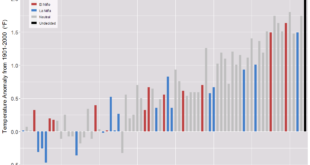The St. Louis Federal Reserve Bank post The White Working Class: National Trends, Then and Now by Bill Emmons, Ana Kent, and Lowell Ricketts (9/24/2019) looks at the share of the U.S. population for Non-Hispanic White and Hispanic or Minority Race (< 4 year degree) and Non-Hispanic White and Hispanic or Minority Race (at least 4 year degree).
Both the white working class’ share and its absolute numbers are shrinking. In fact, our projections indicate that the white working class will be a minority group by 2034.3 Several trends may help to explain this group’s decline. For example, the shares and numbers of white four-year college graduates (i.e., white grads) and nonwhites are increasing.4
Of course, the shrinking absolute numbers of the white working class also contribute. Other researchers have convincingly argued that increases in “deaths of despair”—including alcohol, drug and other opioid-related deaths, and suicides—have hit middle-aged whites with less than a bachelor’s degree particularly hard.5
The article includes four graphs similar to the one copied here but for the four regions of the U.S. one of which the white working class is no longer the largest group. There are also links to the data.

